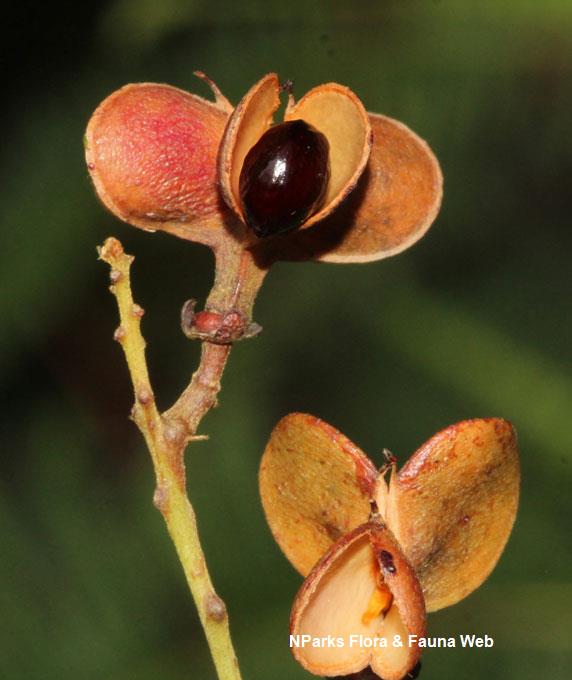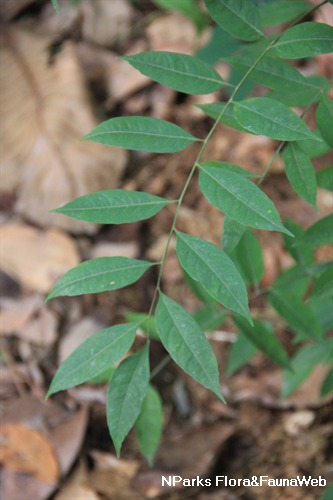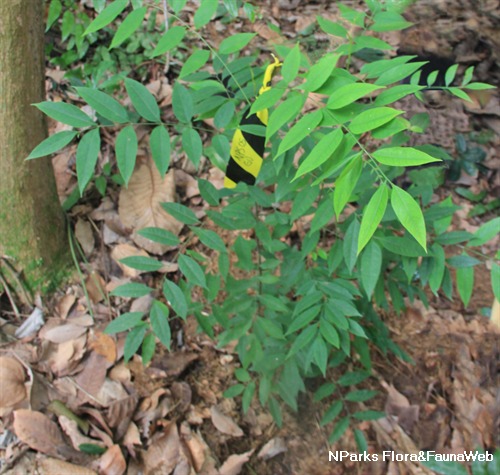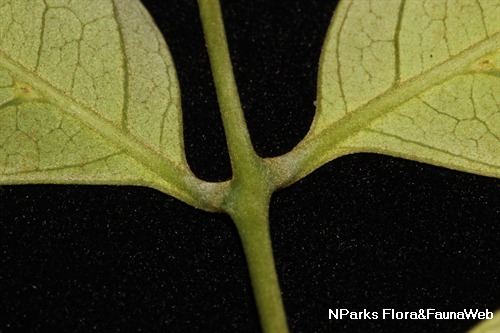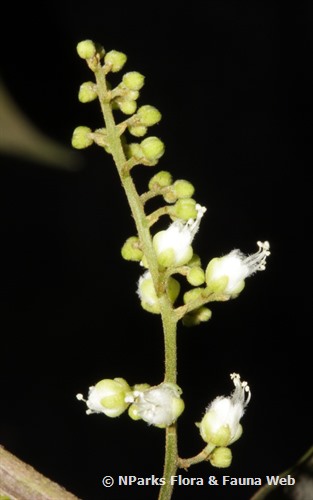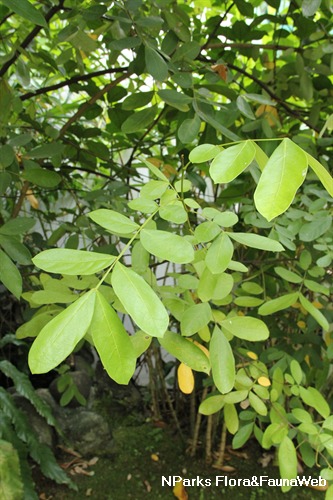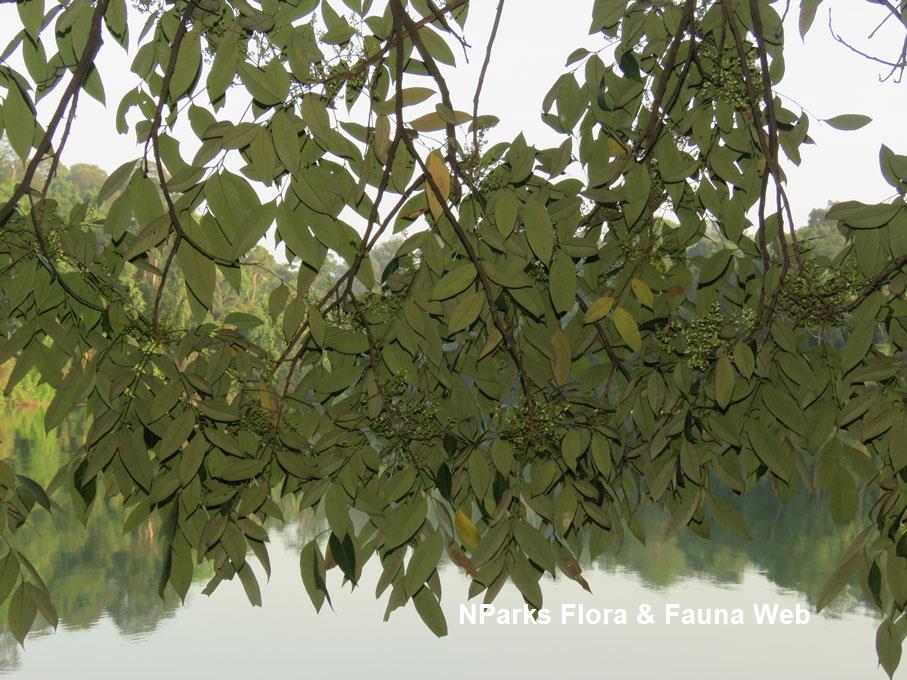
Back
Guioa pubescens (Zoll. & Moritzi) Radlk.
| Family Name: | Sapindaceae |
| Common Name: | Senyamok |
Guioa pubescens or Senyamok is a small to medium sized tree that is native to Singapore. Growing up to 25 m tall, it produces leaflets with an asymmetrical base and veinlets joined in loops, raised below. Flowers are white to yellow, cup-shaped covered in fine hairs on the exterior. The fruit is a 3-lobed capsule that spilt at the base when dried, revealing black dangling seeds covered in a yellow seed covering.
Name
Classifications and Characteristics
| Plant Division | Angiosperms (Flowering Seed Plants) (Dicotyledon) |
|---|---|
| Plant Growth Form | Tree (Small (6m-15m), Medium (16m-30m)) |
| Mode of Nutrition | Autotrophic |
| Maximum Height | 25 m |
Biogeography
| Native Distribution | Sumatra, Peninsular Malaysia, Singapore, Java, Borneo, Philippines |
|---|---|
| Native Habitat | Terrestrial (Coastal Forest, Freshwater Swamp Forest, Primary Rainforest, Secondary Rainforest) |
| Preferred Climate Zone | Tropical |
| Local Conservation Status | Native to Singapore (Least Concern (LC)) |
Description and Ethnobotany
| Growth Form | It is a small to medium sized tree that can grow from 2 - 25 m tall. |
|---|---|
| Foliage | Leaves are evenly-pinnate, up to 6 pairs of leaflets. The leaflets are leathery, egg-shaped to elliptic, often slightly sickle-shaped measuring 2.9 - 20 cm long by 0.8 - 7.2cm wide. Leaflets have an asymmetrical base, veinlets are raised below with its ends joined in loops. Pimple-like (papillate) impressions are found on the underside of the leaflets, likewise the underside is covered in fine silky hairs. |
| Flowers | Flowers are borne on an inflorescence produced along the axils. Flowers are small, round, 5-petalled, white to yellow coloured measuring 3.5 mm - 4.5 mm wide. The outer surface of the sepals and petals are covered in fine hairs. |
| Fruit | The fruit is a 3-lobed capsule that splits at the base when matured. The fruit is sparsely covered in short fine hairs, smooth, lobes are laterally flattened. Each capsule measures 1 - 1.5 cm long and 1 - 1.9 cm wide. The fruit is red when fresh, turning blackish when dried. Upon ripening, it splits open at the base to reveal dangling black seeds enclosed completely in a yellow seed covering (arillode). |
| Habitat | Occurs in primary, secondary forest, kerangas, dipterocarp forests, peat swamp forest, uncommon in coastal forest. Altitude from sea level to 1800 m. <1,2> |
| Associated Fauna | Its flowers are insect-pollinated. |
| Cultivation | It can be propagated by seed. |
| Etymology | Latin Guioa is named after Jose Guio; a Spanish botanical artist in 18th Century. Latin pubescens, soft-hairy, with reference to the fruit. |
Landscaping Features
| Landscape Uses | Suitable for Roadsides, Parks & Gardens |
|---|
Fauna, Pollination and Dispersal
| Pollination Method(s) | Biotic (Fauna) |
|---|
Plant Care and Propagation
| Light Preference | Full Sun |
|---|---|
| Water Preference | Moderate Water |
| Plant Growth Rate | Moderate |
| Rootzone Tolerance | Fertile Loamy Soils, Well-Drained Soils |
| Propagation Method | Seed |
Foliar
| Foliage Retention | Evergreen |
|---|---|
| Mature Foliage Colour(s) | Green |
| Mature Foliage Texture(s) | Leathery |
| Foliar Type | Compound (Even-Pinnate) |
| Foliar Arrangement Along Stem | Spiral |
| Foliar Attachment to Stem | Petiolate |
| Foliar Shape(s) | Non-Palm Foliage (Elliptical, Ovate) |
| Foliar Venation | Reticulate |
| Foliar Margin | Entire |
| Foliar Apex - Tip | Acuminate, Caudate, Cuspidate, Mucronate |
| Foliar Base | Oblique / Asymmetrical, Attenuate |
Non - Foliar and Storage
| Stem Type & Modification | Woody |
|---|---|
| Root Type | Underground (Fibrous Root) |
Floral (Angiosperm)
| Flower & Plant Sexuality | Bisexual Flowers , Bisexual Flowers |
| Flower Colour(s) | Cream / Off-White, Yellow / Golden |
|---|
| Flower Grouping | Cluster / Inflorescence |
| Flower Location | Axillary |
| Flower Symmetry | Bilateral |
| Flowering Habit | Polycarpic |
Fruit, Seed and Spore
| Mature Fruit Colour(s) | Brown |
|---|---|
| Fruit Classification | Simple Fruit |
| Fruit Type | Dehiscent Dry Fruit , Capsule |
| Mature Seed Colour(s) | Black |
References
| References | <1> Welzen P.C.van (1994) Guioa. In: Adema, F., Leenhouts, P.W. & Welzen, P.C.van (ed.) Flora Malesiana, ser. 1, Seed Plants, vol. 11(3), pp.591-592. Leiden: Rijksherbarium. <2> Welzen, P.C.van (2017). Sapindaceae. Flora of Peninsular Malaysia, ser. 2, Seed Plants, vol. 6, pp. 111 - 112. Selangor: Forest Research Institute Malaysia. |
|---|
Image Repository
Others
| Master ID | 29931 |
|---|---|
| Species ID | 4240 |
| Flora Disclaimer | The information in this website has been compiled from reliable sources, such as reference works on medicinal plants. It is not a substitute for medical advice or treatment and NParks does not purport to provide any medical advice. Readers should always consult his/her physician before using or consuming a plant for medicinal purposes. |

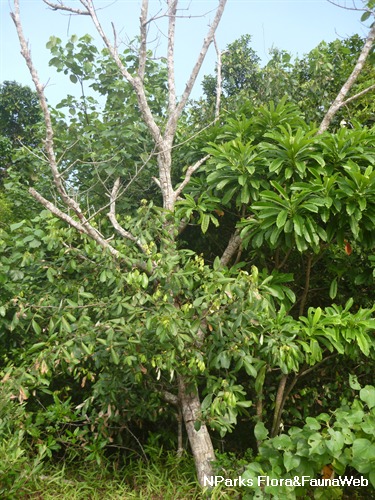
.jpg)
.jpg)
.jpg)
.jpg)
.jpg)
